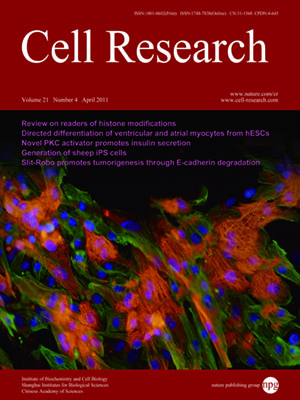
Volume 21, No 4, Apr 2011
ISSN: 1001-0602
EISSN: 1748-7838 2018
impact factor 17.848*
(Clarivate Analytics, 2019)
Volume 21 Issue 4, April 2011: 683-696
ORIGINAL ARTICLES
Malaria parasites form filamentous cell-to-cell connections during reproduction in the mosquito midgut
Ingrid Rupp1,*, Ludmilla Sologub1,*, Kim C Williamson2, Matthias Scheuermayer1, Luc Reininger3, Christian Doerig3, Saliha Eksi2,6, Davy U Kombila4, Matthias Frank5 and Gabriele Pradel1
1Research Center for Infectious Diseases, University of W黵zburg, Josef-Schneider-Strasse 2/D15, 97080 W黵zburg, Germany
2Department of Biology, Loyola University Chicago, 6525 North Sheridan Road, Chicago, IL 60626, USA
3INSERM U609, Global Health Institute/Wellcome Trust Centre for Molecular Parasitology, Ecole Polytechnique F閐閞ale de Lausanne, GHI-SV-EPFL Station 19, CH-1015 Lausanne, Switzerland
4Medical Research Unit, Albert Schweitzer Hospital, Lambar閚? Gabon
5Institute of Tropical Medicine, University of T黚ingen, Wilhelmstr 27, T黚ingen 72074, Germany
6Department of Medical Microbiology, Rize University, Rize 53100, Turkey
Correspondence: Gabriele Pradel,(gabriele.pradel@uni-wuerzburg.de)
Physical contact is important for the interaction between animal cells, but it can represent a major challenge for protists like malaria parasites. Recently, novel filamentous cell-cell contacts have been identified in different types of eukaryotic cells and termed nanotubes due to their morphological appearance. Nanotubes represent small dynamic membranous extensions that consist of F-actin and are considered an ancient feature evolved by eukaryotic cells to establish contact for communication. We here describe similar tubular structures in the malaria pathogen
Plasmodium falciparum, which emerge from the surfaces of the forming gametes upon gametocyte activation in the mosquito midgut. The filaments can exhibit a length of > 100 μm and contain the F-actin isoform actin 2. They actively form within a few minutes after gametocyte activation and persist until the zygote transforms into the ookinete. The filaments originate from the parasite plasma membrane, are close ended and express adhesion proteins on their surfaces that are typically found in gametes, like
Pfs230,
Pfs48/45 or
Pfs25, but not the zygote surface protein
Pfs28. We show that these tubular structures represent long-distance cell-to-cell connections between sexual stage parasites and demonstrate that they meet the characteristics of nanotubes. We propose that malaria parasites utilize these adhesive “nanotubes” in order to facilitate intercellular contact between gametes during reproduction in the mosquito midgut.
malaria; nanotube; Plasmodium; gamete; fertilization; transmission; mosquito
FULL TEXT | PDF
Browse 2420


